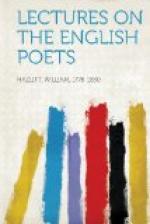It is the same setting sun that we see and remember year after year, through summer and winter, seed-time and harvest. The moon that shines above our heads, or plays through the checquered shade, is the same moon that we used to read of in Mrs. Radcliffe’s romances. We see no difference in the trees first covered with leaves in the spring. The dry reeds rustling on the side of a stream—the woods swept by the loud blast—the dark massy foliage of autumn—the grey trunks and naked branches of the trees in winter—the sequestered copse, and wide-extended heath—the glittering sunny showers, and December snows —are still the same, or accompanied with the same thoughts and feelings: there is no object, however trifling or rude, that does not in some mood or other find its way into the heart, as a link in the chain of our living being; and this it is that makes good that saying of the poet—
“To me the
meanest flower that blows can give
Thoughts that
do often lie too deep for tears.”
Thus nature is a kind of universal home, and every object it presents to us an old acquaintance with unaltered looks; for there is that consent and mutual harmony among all her works, one undivided spirit pervading them throughout, that to him who has well acquainted himself with them, they speak always the same well-known language, striking on the heart, amidst unquiet thoughts and the tumult of the world, like the music of one’s native tongue heard in some far-off country.
“My heart
leaps up when I behold
A rainbow in the
sky:
So was it when
my life began,
So is it now I
am a man,
So shall it be
when I grow old and die.
The child’s
the father of the man,
And I would have
my years to be
Linked each to
each by natural piety.”
The daisy that first strikes the child’s eye in trying to leap over his own shadow, is the same flower that with timid upward glance implores the grown man not to tread upon it. Rousseau, in one of his botanical excursions, meeting with the periwinkle, fell upon his knees, crying out—Ah! voila de la pervenche! It was because he had thirty years before brought home the same flower with him in one of his rambles with Madame de Warens, near Chambery. It struck him as the same identical little blue flower that he remembered so well; and thirty years of sorrow and bitter regret were effaced from his memory. That, or a thousand other flowers of the same name, were the same to him, to the heart, and to the eye; but there was but one Madame Warens in the world, whose image was never absent from his thoughts; with whom flowers and verdure sprung up beneath his feet, and without whom all was cold and barren in nature and in his own breast. The cuckoo, “that wandering voice,” that comes and goes with the spring, mocks our ears with one note from youth to age; and the lapwing, screaming round the traveller’s path, repeats for ever the same sad story of Tereus and Philomel!




